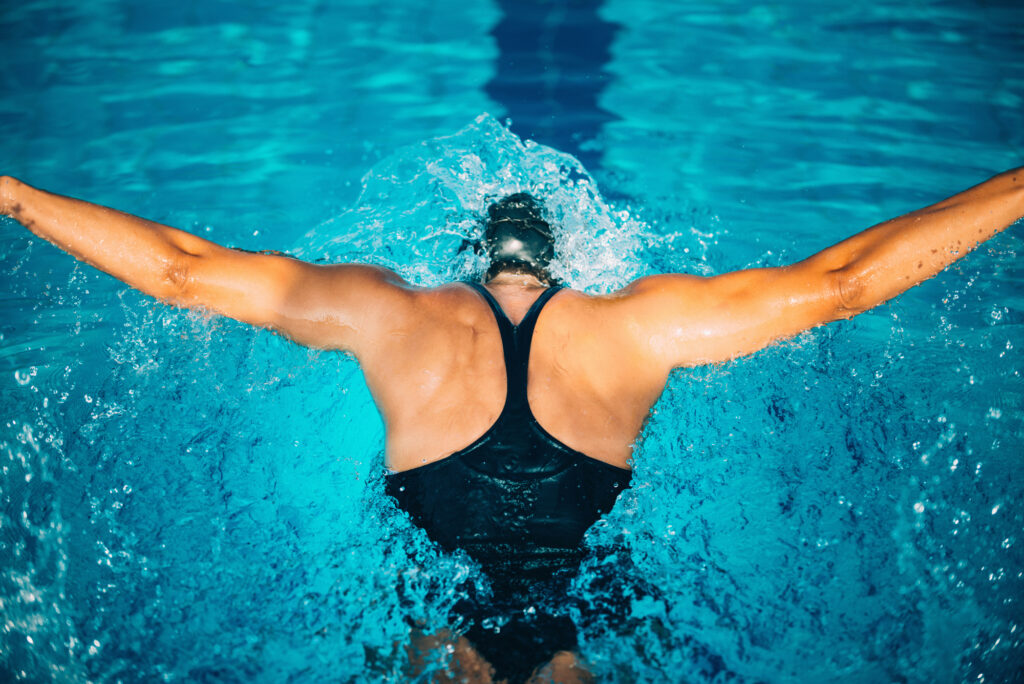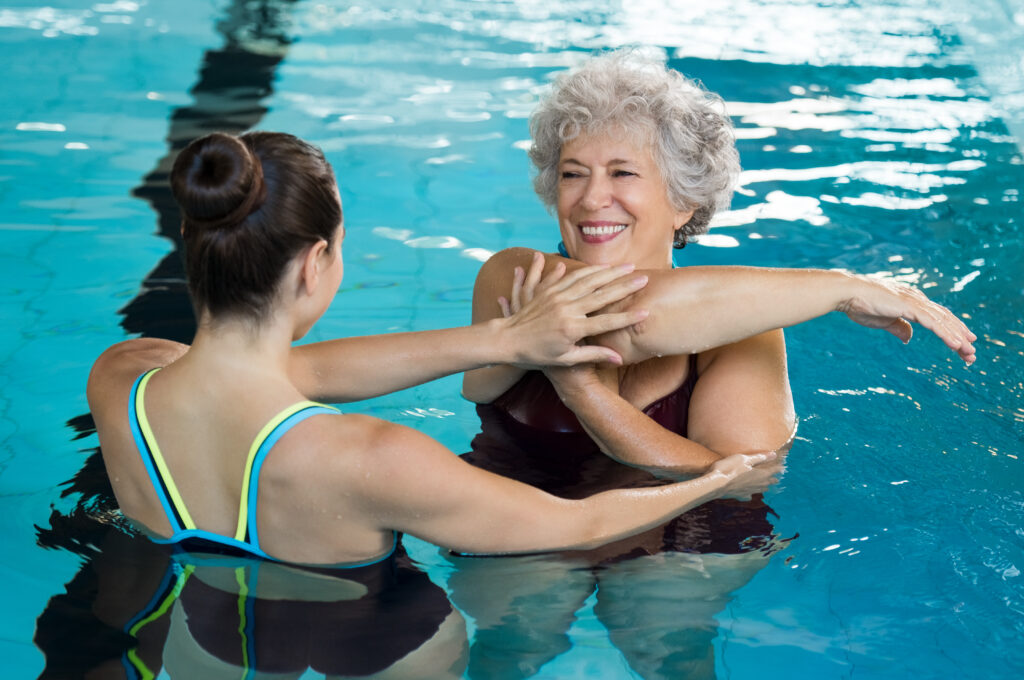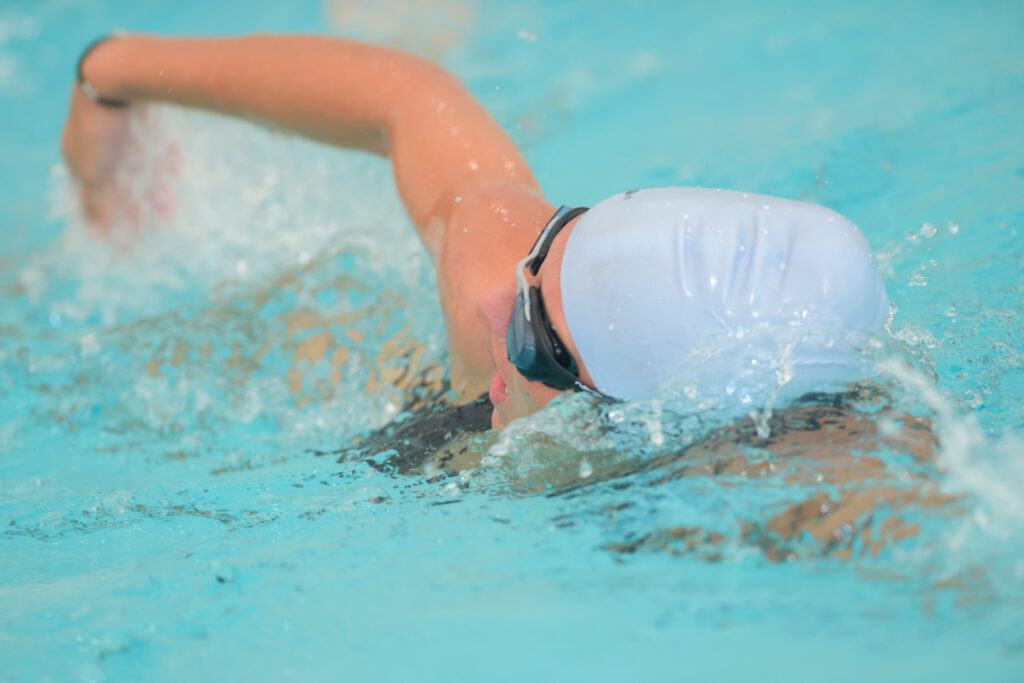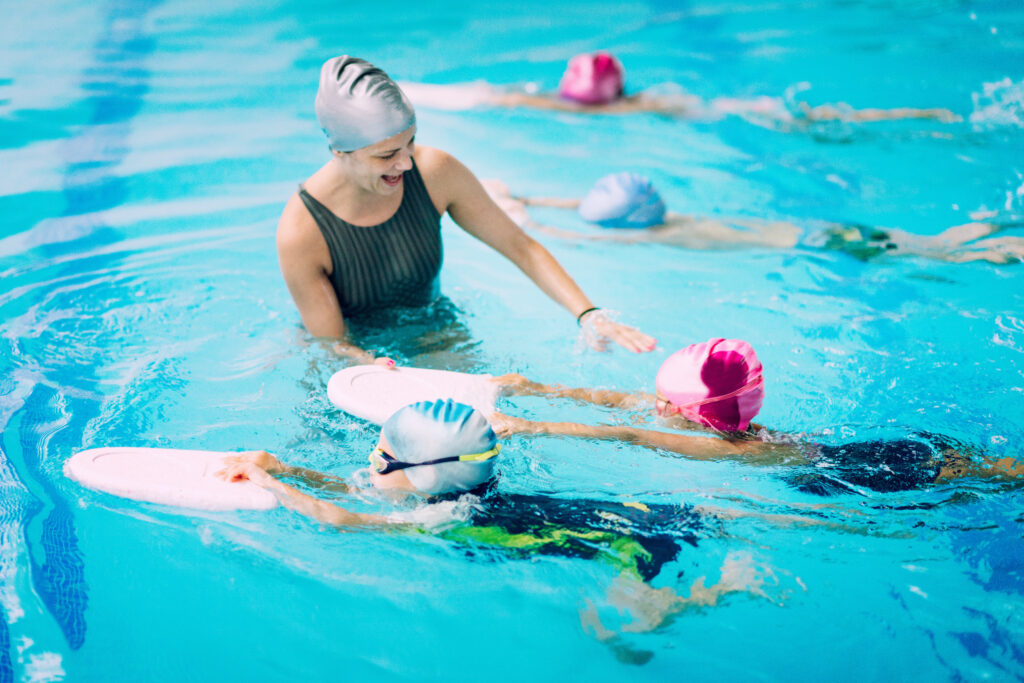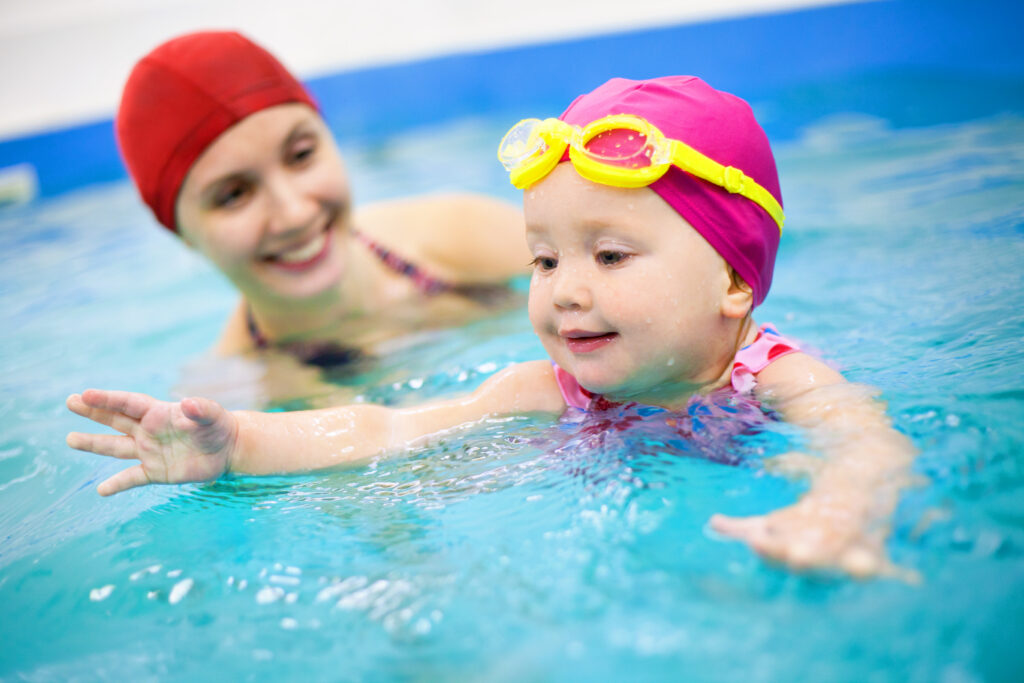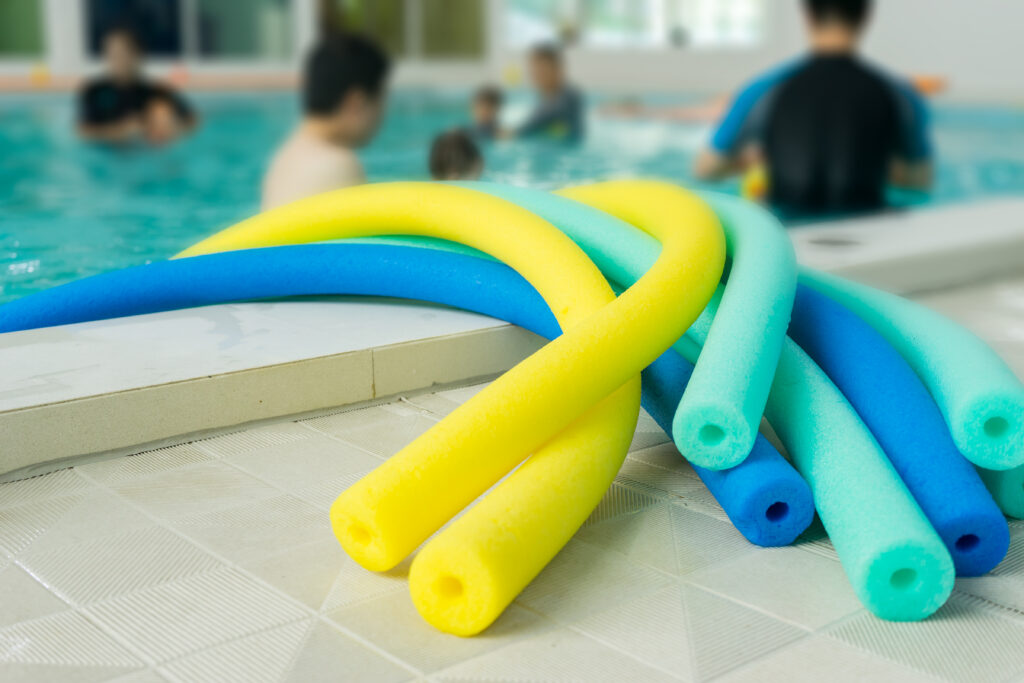Swimming is a fun and healthy activity that offers many benefits. It’s a great workout for your whole body and can help you stay fit and relaxed. There are several swimming techniques to try, each with its own unique movements and challenges.
The four main swimming styles are freestyle, breaststroke, backstroke, and butterfly. Each style has special ways of moving your arms and legs in the water. Some styles are easier to learn than others, but all of them can be mastered with practice and patience.
Learning different swimming techniques can make your time in the water more enjoyable. It can also help you swim faster and use less energy. Whether you’re a beginner or an experienced swimmer, there’s always room to improve your skills and try new styles.
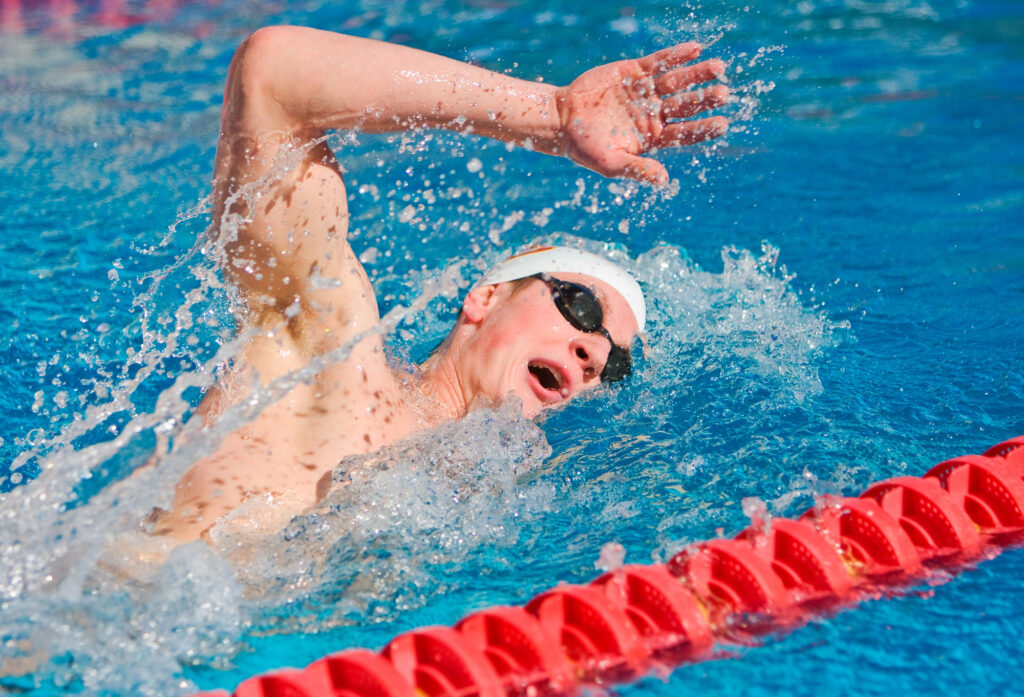
Fundamentals of Swimming
Swimming is a vital skill that requires proper technique and practice. To become a proficient swimmer, one must master several key fundamentals.
Body position is crucial for efficient swimming. A streamlined, horizontal position in the water reduces drag and improves speed. Swimmers should keep their head in line with their spine and look down towards the bottom of the pool.
Breathing technique is essential for maintaining rhythm and oxygen supply. Swimmers should exhale underwater and turn their head to the side for a quick inhalation. This helps maintain a smooth, continuous stroke.
Arm movements propel the body through the water. The catch, pull, and recovery phases of each stroke should be executed with precision for maximum efficiency. Proper technique varies depending on the swimming style.
Leg movements provide additional propulsion and help maintain balance. Kicking from the hips with straight legs and pointed toes generates power and stability in the water.
Body strength and flexibility are important for swimming performance. Core strength helps maintain proper body position, while flexibility in the shoulders and ankles improves stroke efficiency.
Developing a feel for the water is crucial. Swimmers should focus on being hydrodynamic, minimising resistance and maximising propulsion through the water.
Consistent practice and attention to these fundamentals will help swimmers improve their technique and efficiency in the water.
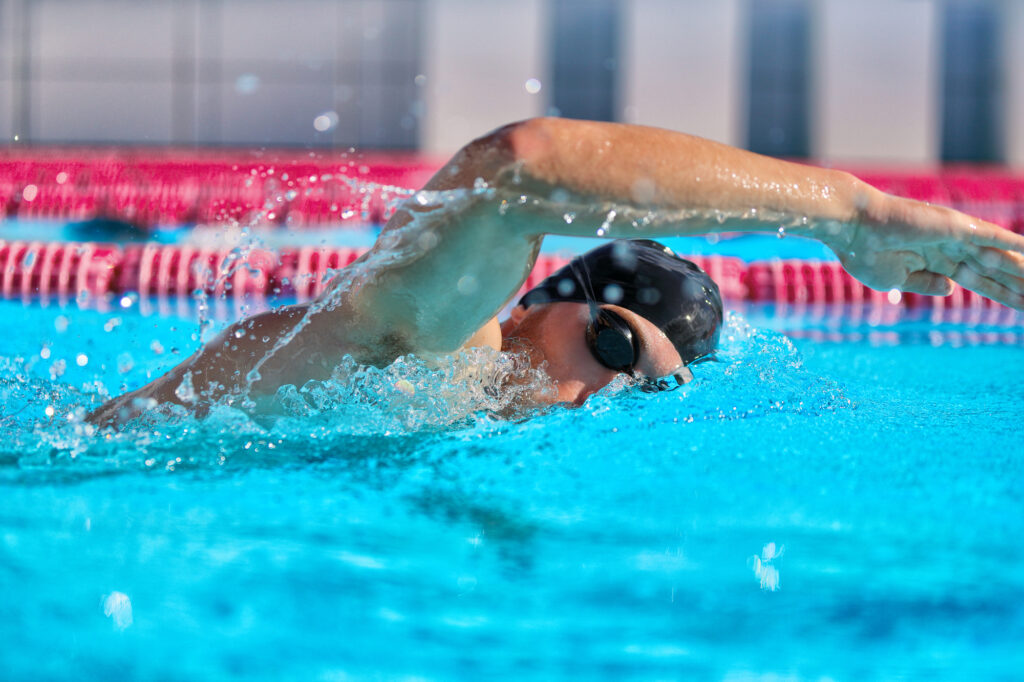
Freestyle Swimming
Freestyle is the fastest and most efficient swimming stroke. It uses a combination of arm movements, leg kicks, and body positioning to propel swimmers through the water with speed and grace.
The Front Crawl
The front crawl is the most common freestyle technique. Swimmers lie face down in the water, rotating their bodies from side to side. The arms move in an alternating pattern, reaching forward and pulling through the water. Keeping the elbows high during the pull phase is crucial for maximising power.
The legs perform a flutter kick, moving up and down in a quick, rhythmic motion. This kick helps maintain body position and adds propulsion. A strong core is essential for connecting the upper and lower body movements.
Proper body positioning is key. Swimmers should aim to keep their bodies as horizontal as possible, with hips high in the water to reduce drag.
Breathing Techniques
Breathing is a vital component of freestyle swimming. Swimmers typically turn their heads to the side to breathe, timing it with their arm strokes. Bilateral breathing, where swimmers breathe on both sides, can help balance the stroke and prevent overreliance on one side.
To breathe effectively:
- Turn your head as one arm recovers above water
- Take a quick breath
- Return your face to the water before the arm enters
Exhale steadily underwater between breaths. This helps expel water and CO2, making inhalation easier. Practice breathing every two, three, or four strokes to find a comfortable rhythm.
Freestyle Drills and Workouts
Drills help refine technique and build endurance. Some effective freestyle drills include:
- Catch-up drill: Focus on arm timing and extension
- Finger-drag drill: Improve arm recovery
- One-arm freestyle: Enhance body rotation and balance
Workouts should include a mix of distances and intensities. A sample workout might be:
- Warm-up: 200m easy freestyle
- Main set: 10 x 50m freestyle on 60 seconds
- Cool-down: 100m easy backstroke
Incorporating drills into regular practice sessions can significantly improve technique and efficiency. Gradually increase workout intensity and duration as fitness levels improve.
Breaststroke Fundamentals
Breaststroke is a unique swimming style that requires proper technique, timing, and coordination. Mastering this stroke involves perfecting the arm and leg movements, synchronising breathing, and practising specific drills.
Breaststroke Technique
The breaststroke technique begins with the body in a streamlined position. Swimmers start with their arms extended forward and legs straight behind. The arm movement involves pulling hands apart to create a large triangle, then sweeping them back towards the chest.
For the leg kick, swimmers perform a whip-like motion known as the frog kick. This involves bending the knees and bringing the heels towards the buttocks, then kicking outwards and back together.
Proper body position is crucial. Swimmers should keep their shoulders, hips, and legs as horizontal as possible, with a slight downward slope to keep the leg kick underwater.
Breaststroke Timing and Coordination
Timing is essential in breaststroke. The stroke follows a specific sequence:
- Glide
- Pull
- Breathe
- Kick
- Glide again
Swimmers should breathe during the arm pull, lifting their head as the hands sweep inwards. As they exhale and lower their head, they initiate the leg kick.
Coordination between arm and leg movements is crucial. As the arms finish the pull and extend forward, the legs complete the kick and come together.
Proper timing allows for a moment of glide between each stroke cycle, maximising efficiency and reducing drag.
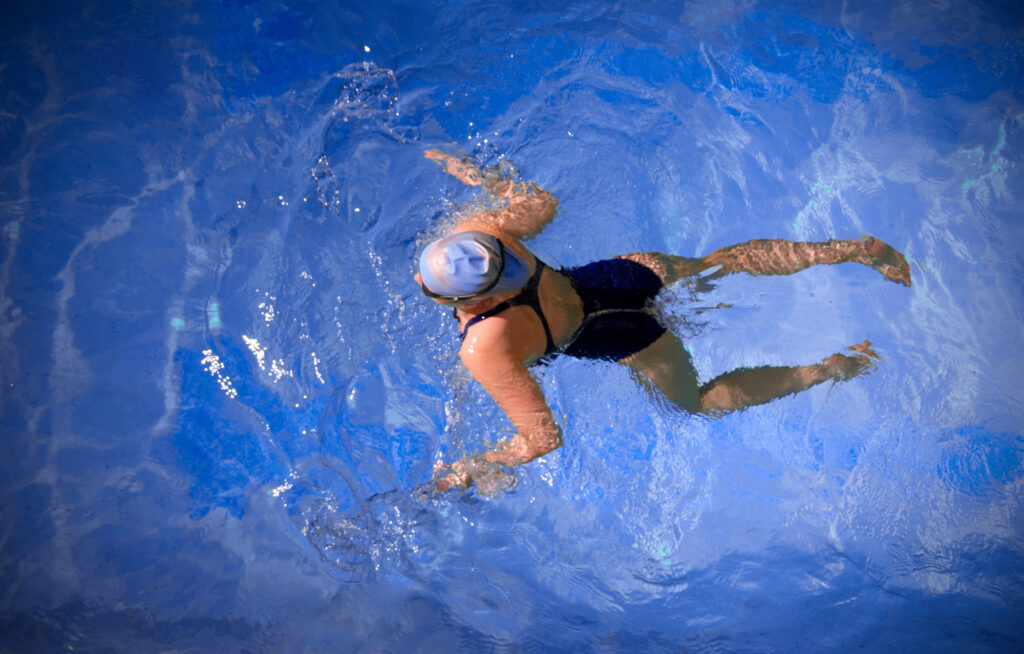
Breaststroke Drills and Training
To improve breaststroke technique, swimmers can practise various drills:
- Pull-Kick-Glide: Focus on each phase separately, then combine them.
- Two-Kicks-One-Pull: Emphasises leg strength and timing.
- Breaststroke with Flutter Kick: Improves arm technique and body position.
Using flotation devices can help isolate specific movements. For example, using a pull buoy between the legs allows swimmers to focus solely on arm technique.
Incorporating dry-land exercises can enhance strength and flexibility. Squats and lunges improve leg power, while shoulder and chest stretches increase arm mobility.
Gradually increase training intensity and distance to build endurance. Mixing breaststroke with other strokes in workouts helps maintain overall swimming fitness.
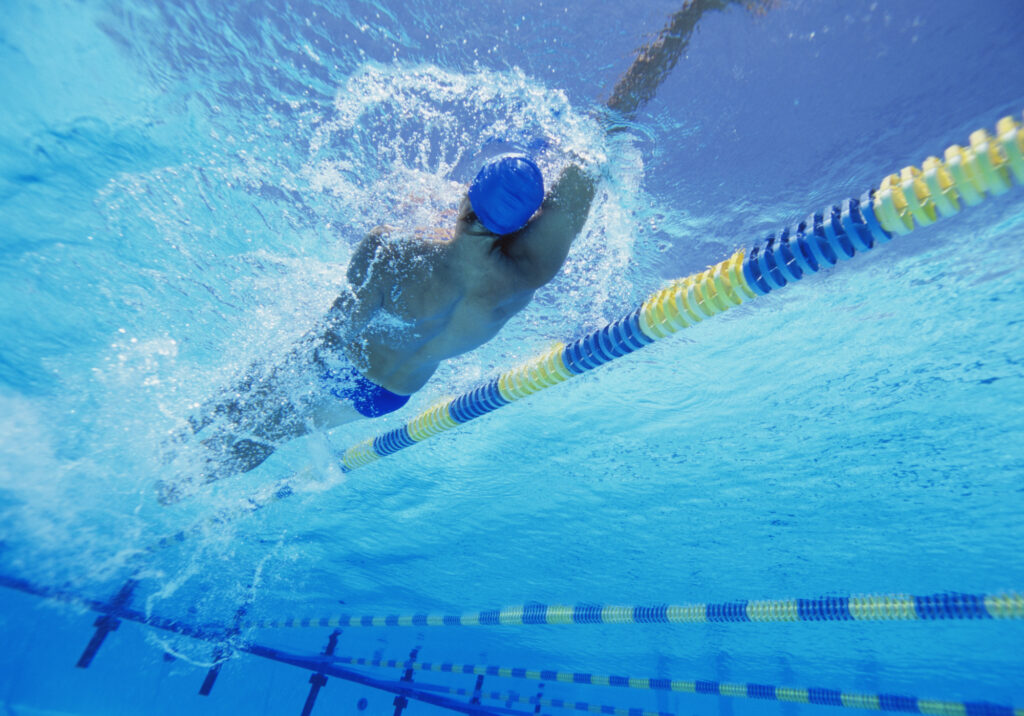
Backstroke Skills and Drills
Backstroke is a unique swimming style that requires proper technique and practice. Mastering this stroke involves perfecting body position, arm movements, and leg kicks.
Mastering the Backstroke
To swim backstroke effectively, start by lying on your back in the water. Keep your head still and look straight up. Your ears should be submerged, with water at eye level.
Use a flutter kick, moving your legs in an alternating up-and-down motion. Keep your knees slightly bent and toes pointed. This kick helps propel you through the water.
For arm movements, rotate your shoulders as you pull. Reach behind your head with one arm, then pull it down to your hip. As one arm finishes, the other should begin its stroke. This creates a continuous, smooth motion.
Breathe steadily throughout the stroke. Since your face is above water, breathing is easier than in other strokes. Inhale as one arm exits the water, and exhale as it re-enters.
Backstroke Variations
The elementary backstroke is a simpler version of the standard backstroke. It’s often taught to beginners. In this variation, both arms move together instead of alternating.
To perform the elementary backstroke, start on your back with arms at your sides. Bring your hands up to your chest, then push them out to the sides and down to your hips. This creates a ‘rocket ship’ motion.
For the leg movement, bend your knees and bring your heels towards your bottom. Then, kick out in a whip-like motion. This is similar to the breaststroke kick but done on your back.
Practise backstroke drills to improve your technique. Try the one-arm drill, swimming with just one arm while keeping the other at your side. This helps focus on proper arm technique and body rotation.
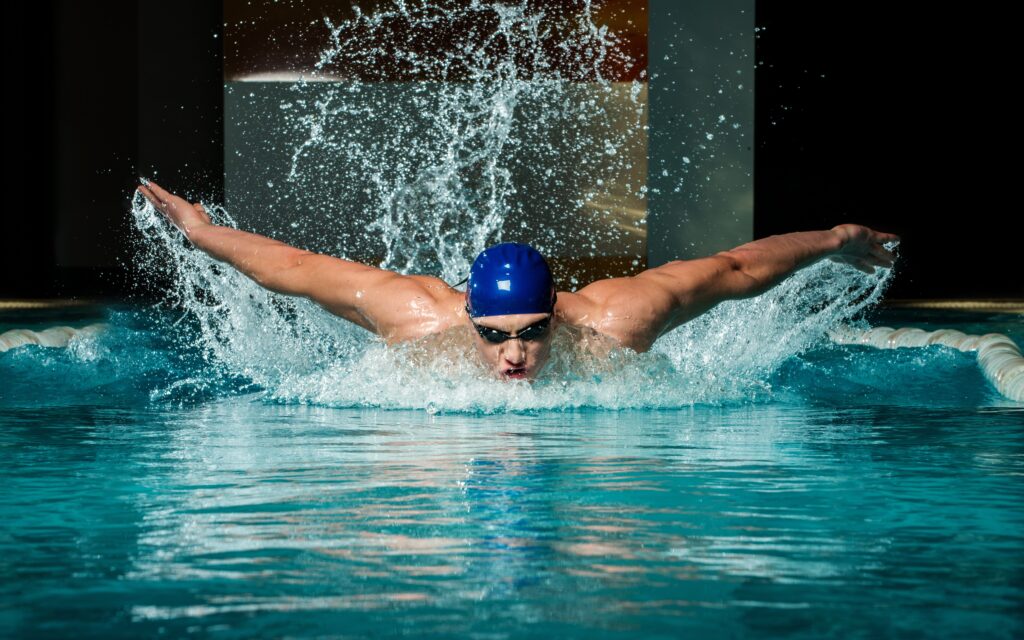
Butterfly Stroke Techniques
The butterfly stroke is a challenging yet powerful swimming technique. It requires strength, coordination, and proper form to execute effectively. Let’s explore the key components of mastering this dynamic stroke.
Butterfly Stroke Mechanics
The butterfly stroke involves a dolphin-like motion of the body. Swimmers start in a prone position with arms extended forward. The stroke begins with a simultaneous arm pull, followed by a recovery phase where both arms swing over the water.
The legs perform a dolphin kick, with feet together, moving up and down in unison. This kick provides propulsion and helps maintain body position. Proper timing is crucial for efficient movement through the water.
Swimmers should focus on a strong catch phase, pulling water backwards with cupped hands. The pull should accelerate as arms move towards the hips, maximising propulsion.
Butterfly Breathing and Rhythm
Breathing in butterfly is challenging but vital for performance. Swimmers typically breathe to the front every two strokes, lifting their head and shoulders out of the water as the arms recover.
Timing is key. Inhale quickly as the arms exit the water, and exhale forcefully underwater during the pull phase. This rhythm helps maintain momentum and reduces drag.
Some swimmers prefer side breathing, which can be less disruptive to body position. Experiment with both techniques to find what works best for you.
Maintain a steady rhythm throughout the stroke cycle. The arms should enter the water as the second kick occurs, creating a smooth, continuous motion.
Butterfly Training and Exercises
To improve butterfly technique, focus on specific drills and exercises. One-arm butterfly drills help refine arm movement and timing. Perform these drills with one arm extended while the other completes the stroke cycle.
Dolphin kick drills on the back or side strengthen the core and leg muscles. Practice kicking with a kickboard to isolate leg movement and build endurance.
Dry-land exercises like push-ups and pull-ups enhance upper body strength. Core workouts, including planks and Russian twists, improve body control in the water.
Incorporate short butterfly sets into your training routine. Start with 25-metre repeats, gradually increasing distance as technique and fitness improve. Remember to maintain proper form throughout each set.
Competitive Swimming and Events
Competitive swimming involves various events that test swimmers’ speed, endurance, and technique. These events range from individual races to team relays, each requiring specific skills and strategies.
Swimming in Competitions
Competitive swimming takes place in pools of different lengths. Olympic-sized pools measure 50 metres, while short course pools are 25 metres long. Races are timed, and swimmers aim to complete the distance as quickly as possible.
Events are categorised by stroke and distance. Common distances include:
- Sprint events: 50m and 100m
- Middle distance: 200m and 400m
- Long distance: 800m and 1500m
Swimmers must follow strict rules for each stroke. Judges watch closely to ensure proper technique and fair starts and turns.
Medley Swimming
Medley events showcase a swimmer’s versatility across all four competitive strokes. The individual medley (IM) includes butterfly, backstroke, breaststroke, and freestyle, swum in that order.
Common IM distances are:
- 200m (50m of each stroke)
- 400m (100m of each stroke)
Swimmers must transition smoothly between strokes while maintaining speed. Medley events require well-rounded skills and strategic pacing to excel in all four strokes.
Relay Races and Team Strategies
Relay races add excitement and teamwork to competitive swimming. Four swimmers each complete a leg of the race, with precise transitions between teammates.
Popular relay events include:
- 4x100m freestyle relay
- 4x200m freestyle relay
- 4x100m medley relay
In medley relays, each swimmer performs a different stroke in this order: backstroke, breaststroke, butterfly, and freestyle. Teams must consider each swimmer’s strengths when deciding the lineup.
Relay strategies involve:
- Selecting the best order for swimmers
- Practising smooth changeovers
- Encouraging team spirit and motivation
Relay races often produce thrilling finishes and showcase the importance of teamwork in swimming.
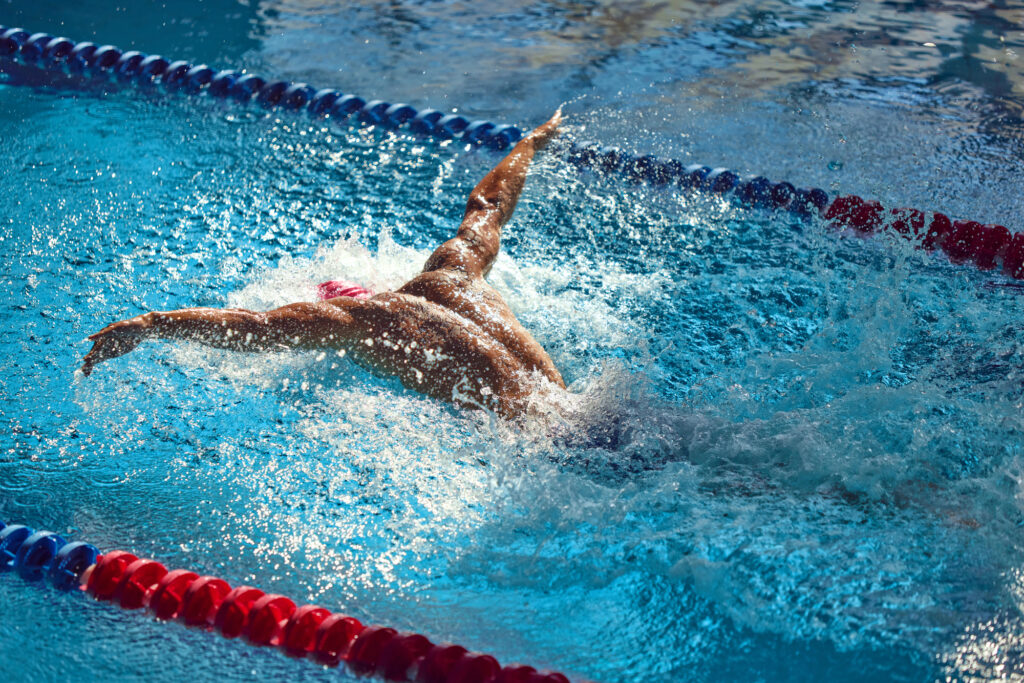
Improving Swimming Efficiency
Swimming efficiency is crucial for better performance and less fatigue. Proper technique and the right tools can help swimmers move through the water with less effort and more speed.
Advanced Swimming Techniques
To boost efficiency, swimmers should focus on body positioning and streamlining. Keep the body straight and aligned with the water’s surface. Use a slight body roll with each stroke to reduce drag and increase power.
Practise gliding after each push-off from the wall. This helps maintain momentum and conserve energy. Work on hand entry and catch techniques to pull more water with each stroke.
Breathing is key. Learn to breathe bilaterally (on both sides) to balance muscle use and maintain a straighter path through the water. Exhale fully underwater to avoid lifting the head too high when breathing.
Kick from the hips, not the knees, for a more hydrodynamic leg movement. Keep kicks small and quick to reduce drag while still providing propulsion.
Swimming Aids and Training Tools
Various aids can improve technique and efficiency:
- Pull buoys: Place between legs to focus on upper body technique
- Kickboards: Isolate leg movements for stronger kicks
- Hand paddles: Increase resistance for arm strength
- Fins: Improve ankle flexibility and kick power
Swim mirrors are useful for checking technique underwater. They allow swimmers to see their form and make real-time adjustments.
Dryland training with resistance bands can build swim-specific strength. This translates to more powerful strokes in the water.
Using a tempo trainer helps develop a consistent stroke rhythm. This leads to better pacing and more efficient energy use over longer distances.
Remember, swimming is a full-body workout. Balanced training of all muscle groups is essential for overall efficiency and performance in the water.
Swimming for Lifesaving and Fitness
Swimming is a vital skill for safety and an excellent form of exercise. It can save lives in emergencies and provide a low-impact, full-body workout for people of all ages and fitness levels.
Lifesaving Techniques in Swimming
Lifesaving techniques are crucial for water safety. The side stroke is an efficient method for rescuing others, as it allows the swimmer to support a person whilst moving through water.
Treading water is another essential skill. It helps swimmers conserve energy whilst staying afloat in deep water. This technique involves moving the arms and legs in a circular motion.
The survival backstroke is useful for conserving energy over long distances. Swimmers lie on their backs, using a frog-like kick and pulling their arms from their hips to their armpits.
For rescuing conscious victims, the cross-chest carry is effective. The rescuer approaches from behind, grasping the victim’s chin with one hand and swimming on their side.
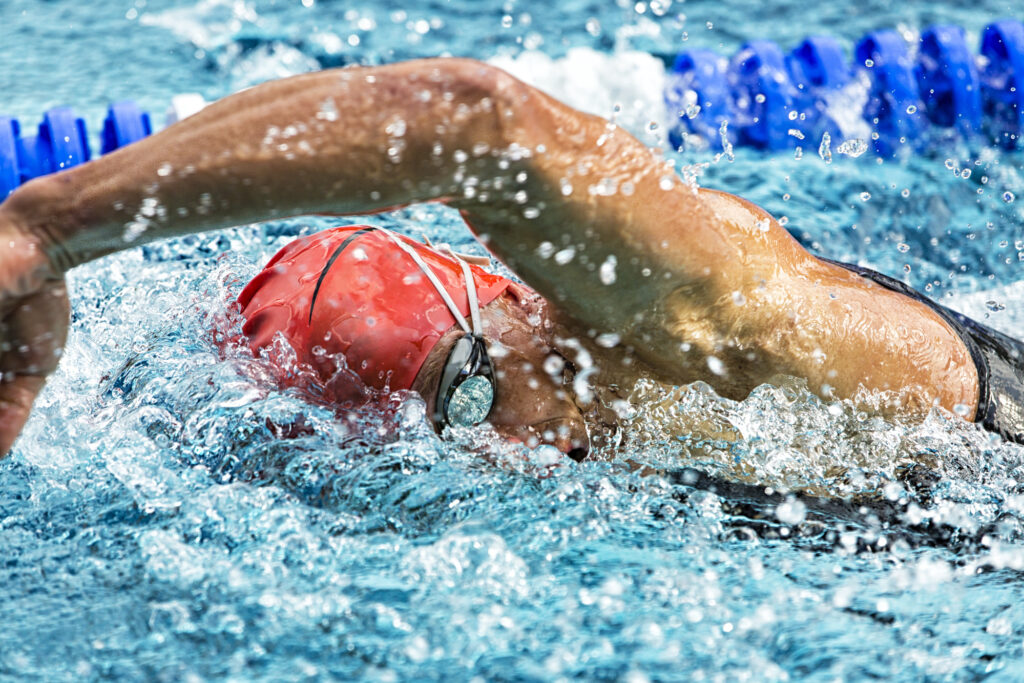
Swimming for Health and Fitness
Swimming offers a fantastic form of exercise that works the entire body. It improves cardiovascular health, builds muscle strength, and enhances flexibility.
Different strokes target various muscle groups:
- Freestyle: Works arms, shoulders, and core
- Breaststroke: Strengthens legs and pectorals
- Backstroke: Targets back muscles and improves posture
- Butterfly: Provides a full-body workout
Swimming is gentle on joints, making it ideal for those with injuries or arthritis. It also burns calories effectively, with a 30-minute session burning up to 250 calories.
To improve fitness, swimmers can try interval training. This involves alternating between high-intensity laps and recovery periods. Adding equipment like pull buoys or kickboards can target specific muscle groups and add variety to workouts.

